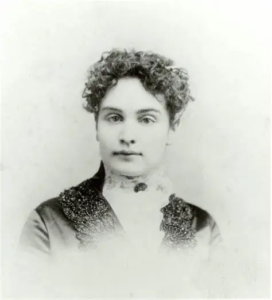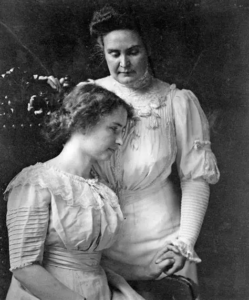How Anne Sullivan Taught Helen Keller to Communicate

Stricken deaf, blind, and mute by a childhood illness, Helen Keller learned to read, write, and speak thanks to the efforts of her miracle-working instructor, Anne Sullivan, who also became a friend and companion. But how exactly did Sullivan manage to connect with a student who couldn’t see or hear? Today, we’re going to take a look at how the miracle worker Anne Sullivan taught Helen Keller to communicate.
Anne Sullivan’s Early Life
Anne Sullivan was born in 1866 to poor, illiterate Irish immigrants in Massachusetts. Out of five children, she and her brother were the only ones to survive into adulthood. She lost her mother to tuberculosis when she was just nine, and her father, an alcoholic, soon abandoned the children. Anne was placed in Tewkesbury’s almshouse, a nearby poorhouse.
Due to a bacterial infection of the eyes called trachoma, Sullivan lost most of her sight at the age of five and underwent several surgeries to try and repair the damage. Despite these struggles, she was determined to improve her life.
In 1880, after personally pleading with the state of Massachusetts, Anne Sullivan was sent to the Perkins School for the Blind. Although teased for her poverty, she focused on learning and formed close bonds with her teachers. Sullivan quickly caught up intellectually and mastered communication methods such as finger spelling and palm writing—skills that would prove essential for teaching Helen Keller.
Thanks to surgeries, Sullivan gradually regained some of her sight. By 1882, she was able to read print, and in 1886 she graduated as valedictorian of her class.
Laura Bridgman: A Predecessor
Before Helen Keller, there was Laura Bridgman—the first blind and deaf English speaker to learn to communicate using finger spelling and writing. After contracting scarlet fever as a child, Bridgman lost her sight, hearing, smell, and most of her sense of taste. She created her own ways of communicating with family members through gestures and movements.
In 1837, she enrolled at what later became the Perkins School for the Blind, where she learned to read raised print and spell words using hand signals and block writing. By 1850, she was studying advanced subjects like history, philosophy, and mathematics. Bridgman became internationally famous, even catching the attention of Charles Dickens.
By the time Anne Sullivan arrived at Perkins in 1880, Bridgman had already been there for nearly 50 years. Sullivan learned from her, often reading to her and observing how teachers communicated with her.
Helen Keller’s Early Struggles

At 19 months old, Helen Keller was struck with an unknown illness that left her blind and deaf. Once an inquisitive child, she became frustrated and angry without a way to communicate. Sometimes she used grunts and gestures, but often she lashed out in tantrums.
Helen’s parents, however, were determined to help her. After reading Dickens’ account of Laura Bridgman in American Notes, they grew hopeful. They consulted numerous doctors and eventually met Alexander Graham Bell, who recommended they contact the Perkins School for the Blind. Perkins responded by sending their brightest graduate, Anne Sullivan, to Alabama.
Anne Meets Helen
Anne Sullivan arrived at the Keller home on March 3, 1887. Seven-year-old Helen was defiant, violent, and unmanageable. Sullivan immediately began spelling words into Helen’s hand, though at first Helen didn’t understand.
One incident at the dinner table highlighted Anne’s determination. When Helen tried to grab food from her plate, Anne smacked her hand with a spoon until she stopped. Though Helen threw a fierce tantrum, Sullivan ignored it and continued eating, showing the same stubbornness that would make her a great teacher.
The Breakthrough: “W-A-T-E-R”
Sullivan used methods inspired by Laura Bridgman and Perkins. She spelled words into Helen’s hand while associating them with objects. Still, Helen struggled to connect the gestures with meaning.
That changed one day when Sullivan spelled W-A-T-E-R into Helen’s hand while running water over it. Suddenly, Helen understood—objects had names. This was her breakthrough moment.
Within weeks, Helen had learned over 100 words for objects, actions, and concepts. She became insatiable in her desire to learn.
Anne Sullivan Learning Beyond the Classroom
Keller’s curiosity led Sullivan to abandon traditional structured lessons. Instead, they spent much time outdoors, where Helen learned by experiencing the world. She delighted in sunlight, flowers, and trees, later writing,
“All my early lessons have in them the breath of the woods, the fine resonance odor of pine needles, blended with the perfume of wild grapes.”
Through Sullivan, Keller also studied arithmetic (though she disliked it), botany, zoology, and writing. She wrote to family, to the Perkins director, and even to Alexander Graham Bell.
By 1890, Keller was learning to speak by feeling her teacher’s lips, cheeks, and throat. Through repetition, she eventually succeeded in speaking to her family—a moment filled with pride and joy.
Anne Sullivan “Spelling Monster”
Sullivan soon found herself with a “spelling monster” on her hands. Helen spelled words constantly—upon waking, throughout the day, and even to herself if no one else was available. Sullivan noted that Keller carried on lively conversations with herself, showing how ingrained language had become.
In 1888, Sullivan and Keller visited the Perkins School, where Helen met other blind and deaf children. She began spending winters there, broadening her experiences.
Anne Sullivan Fame and Recognition
In 1892, Helen was accused of plagiarizing a poem, “The Frost King,” which caused both her and Sullivan to leave Perkins. By then, however, they were gaining recognition thanks to Alexander Graham Bell’s writings. They even met President Grover Cleveland and later befriended Mark Twain, who coined the term “miracle worker” to describe Sullivan.
Anne Sullivan College and Later Life
In 1900, Sullivan accompanied Keller to Radcliffe College, spelling lectures and translating textbooks. The work strained her eyesight and health, but it paid off when Keller graduated in 1904 with a bachelor’s degree.
Sullivan married John Albert Macy in 1905 but continued to work with Keller. In 1914, Polly Thompson joined as Keller’s secretary and later became her companion after Sullivan’s death in 1936.
Anne Sullivan Legacy
Thanks to Anne Sullivan’s education, Helen Keller never stopped learning. Keller went on to become a celebrated author, poet, and humanitarian, advocating for the blind, deaf, and disadvantaged.
In her autobiography, Keller wrote:
“It was my teacher’s genius which made the first years of my education so beautiful. How much of my delight in all beautiful things is innate and how much is due to her influence I can never tell. All the best of me belongs to her.”
Anne Sullivan wasn’t just a teacher—she was truly a miracle worker.



